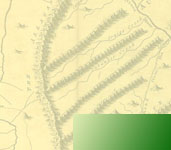North Hill
- Archaeology
- History
See the artifacts on the Digital Archaeological Archive of Comparative Slavery
Archaeologists have found two sites, located near the eastern boundary of the modern Poplar Forest property, that are associated with the Old Plantation complex. They named the earliest site "The North Hill Site," but this is not a name that Jefferson ever used.
The North Hill Site was located on a slope above a spring. Archaeologists excavated there between 1995 and 1998. Most of the site had been disturbed by plowing in the 19th and 20th centuries, and the eastern portion of the site had been further disturbed by adjoining property owners who roto-tilled it as part of their vegetable garden. Nevertheless, archaeologists found a single subfloor pit, originally located within a log cabin, a second, smaller pit that was located in the yard outside of the cabin, and a natural erosion gully that had been filled with trash by the 18th-century inhabitants of the site. They collected soil samples for chemical analysis, and screened the plowed soils for artifacts across a broad area which allowed them to study the organization and use of space outside of the cabin.
Archaeologists also found sections of a narrow trench associated with a wattle fence at the site. The fence had been built with slender posts set into the trench at close intervals (and probably supported by woven twigs, vines or branches above ground). The trench which supported the fence cut through the fill of the erosion gully, thus indicating that it was a later feature at the site. Part of the NEH-sponsored project will include a close look at the association between the features at the site.
Archaeologists also found thousands of artifacts at the site. The majority were nails and clay daub associated with the house itself. Smaller numbers of personal and household artifacts were also found, including a variety of ceramics dating from the 1750s to 1780s, white ball clay and local red clay tobacco pipe fragments, bottle glass, glass beads and a paste jewel, copper alloy buttons, shoe buckles, and clothing fasteners known as aiglets, utensils, lead shot, animal bones, and burned plant material. The full artifact catalogue, as well as further information about the site, can be accessed at www.daacs.org. As part of this project, artifacts from the North Hill will be compared to those found at Wingo's to better understand similarities and variability between the two assemblages.
Although the North Hill cabin may have been settled earlier than Wingo's, both were occupied during the 1770s and early 1780s. Each provides important information about the earliest years of settlement at Poplar Forest by enslaved people.
The North Hill Site
Thomas Jefferson married Martha Wayles Skelton, a young widow, in January 1772. In 1773, following the death of her father, she was apportioned almost 11,000 acres of land spread across several plantations, as well as 135 enslaved people living on those properties. Included in her inheritance was Poplar Forest, consisting of approximately 5,000 acres of land, and the slaves who live there.
When her father John Wayles had owned the Poplar Forest property, the main portion of farmed land was in an area south of the north branch of Tomahawk Creek, which Jefferson later referred to as "the Old Plantation." Although the exact date of settlement is unclear, court records indicate that there were slaves living at Poplar Forest by the 1760s. When Jefferson made his first list of slaves in 1774, a single family-- made up of Guinea Will, Bess, and their three young children, Hall, Dilcy and Suckey--lived there. Guinea Will and Bess likely lived at Wayles' Guinea plantation in Amelia County before he moved them to Poplar Forest. Another young man, known as Billy or Billy Boy, also appears on Jefferson's slave list. He worked as a blacksmith. Additional enslaved individuals and families probably lived at Poplar Forest prior to 1774 and were inherited by other heirs to Wayles' estate and moved off the property after his death.
Jefferson recorded the names of five young adults (John, Davy, Mary, Doll, and Charles ) who were living at the Wingo's quarter farm in January of 1774. Unlike Guinea Will's family and Billy the smith, none of these young people lived at Poplar Forest for more than a decade.



